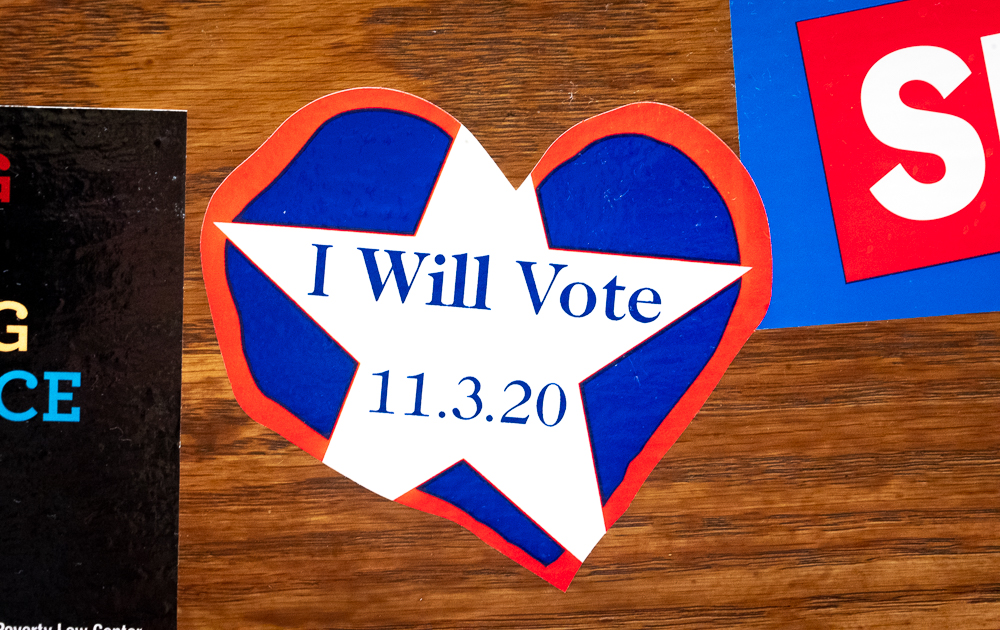
Sam Podnar is a senior at NASH. When she's not writing, she enjoys baking, reading, and talking too much about local politics.


Across the nation, youth activists are organizing to win the right for 16-year-olds to have a say at the ballot box.
September 14, 2021
I had my first brush with civic engagement in third grade, when I walked into the makeshift polling booth at my elementary school and proudly cast my ballot for whichever candidate my parents told me to vote for. A page in the yearbook commemorates the occasion and announces the victor—headline reading, “PEEBLES PRESIDENTIAL ELECTION: OBAMA WINS!!!”
Nine years later, and that Obama vs. Romney mock election is still the closest I’ve come to legitimately voting. Despite being actively engaged in local politics, working on a political campaign, and taking “I voted” stickers whenever I’m at the polls—if that’s considered voter fraud, tell Matt Gaetz I’ve fled the country—I’m counting down the months until I can vote myself. The day won’t come until the midterms, over a year from now; I’ll miss the primaries this spring by just a few days.
But some teens aren’t interested in waiting. There’s a solution that doesn’t involve sitting around until the clock strikes midnight on their 18th birthday: pushing for their right to vote now.
Current activists can look to past advancements to fuel their hope of lowering the voting age.
Vote16USA advocates for lowering the voting age to 16, as the organization’s name suggests. Founded in 2015, its members are active across the country, with specific campaigns underway in places such as Palo Alto and Washington, D.C. The organization represents a growing movement to lower the voting age to 16, which, while in existence for several years now, especially picked up steam in the wake of the Parkland shooting in 2018.
Teens who take to town council meetings and state house floors to advocate for their right to vote can see their mirror image in a past generation. In the ‘60s, young people lived in a country where the voting age was 21 in most states—and they also lived in a country shaken by war and civil unrest. As 18-year-olds watched their peers get drafted into the war effort and lived in fear themselves of getting shipped off to Vietnam, they wielded a compelling slogan: “Old enough to fight, old enough to vote.” This anger at the age of conscription, concentrated among college students eager to get involved and propelled by the momentum of other movements in the 60s, swept across the nation. In July of 1971, the 26th Amendment was ratified, lowering the voting age to 18 for all states.
But there are a few key differences between the movement of today’s activists and that of the ‘60s: success and longevity. The 18-year-olds of the past spent a decade rallying broad public support for their cause, and when the 26th Amendment swept through Congress and the states, it was ratified overwhelmingly and quickly. Seeing as the movement to grant 16-year-olds the right to vote is relatively young, the country will have to wait and see what happens, but young activists need considerably more public support if they want their movement to succeed.
However, they do have something to capitalize on: a rising wave of youth engagement in politics, especially in light of the hectic 2020 election and COVID-19 pandemic. Voter turnout among 18-29 year-olds is trending upward, having increased 11 percentage points from the 2016 to 2020 presidential election. And young people are motivated and involved in ways outside of the polls. The amount of 18-24 year olds in 2020 who believed their age group could change the country and of young people who said that they’ve advocated during a march or demonstration both has risen 11 percentage points since 2018. As increased political engagement among this motivated generation takes shape at the national level, can and should that enthusiasm be channeled into more official forms of civic engagement?
Proponents argue that lowering the voting age will encourage young people to get involved in their communities, research relevant issues, and form a habit of voting early (if you vote in one election, you’re more likely to also vote in the next). They cite research indicating that, by the time an individual hits 16, they have enough civic education to cast an informed vote; allowing young people to vote will even strengthen civic education by enabling teens to apply their knowledge and learn with the intent of making an impact. And because many 16- and 17-year-olds drive, work, pay taxes, and are affected by decisions of the government, advocates say it’s only fair that they should have a stake in the game.
“When we look down the road, we don’t see a hopeful future. We don’t see a future where we’ll have access to clean water and clean air, and equitable schools,” said young activist Tyler Okeke. “Voting is just the logical next step in making sure that a generation—that is so passionate about change and is so deeply affected by the decisions that are being made now—that we are inserted into policy-making and have a say in our democracy.”
The movement is backed by plenty of lawmakers at the federal level, though nothing close to a majority. In 2019, 126 members of the House of Representatives cast ballots in support of a proposal introduced by Representative Ayanna Pressley to lower the voting age to 16. Prominent figures such as 2020 presidential candidate Andrew Yang and Speaker of the House Nancy Pelosi have also voiced their support for the effort.
But opponents of lowering the voting age are far more plentiful. A 2019 poll found that American adults overwhelmingly oppose lowering the voting age, with 84% rejecting granting 16-year-olds suffrage. Though older individuals and Republicans were more likely to be opposed, a large majority of 18- to 34-year-olds and Democrats responded the same way.
Jennifer Braceras, senior fellow with the Independent Women’s Forum and former Commissioner of the United States Commission on Civil Rights, outlines concerns shared by many who don’t want to lower the voting age: that teens younger than 18 are too immature to responsibly cast their ballots and that they won’t be as impacted by their votes as adults. She writes, “At 16, most kids have little awareness of politics, civics, or American history, and they have little life experience to inform their decisions. Although a small percentage may work or even contribute to household expenses, few hold full-time jobs or fully care for themselves. Most don’t even pay for their own cellphones—let alone groceries, rent, utility bills, or property taxes. Simply put, they don’t have enough skin in the game.”
Braceras continues, also outlining a big concern among Republicans: “It doesn’t take a genius to figure out that Democrats like Pressley want to lower the voting age in order to increase the pool of potential Democratic voters.” Young people do tend to lean more liberal—as Republicans worry about racial demographic shifts in the coming decades that threaten their power in the country, expanding the national constituency to include younger, more progressive voters would likely hinder them.
And citizens on the younger end of the spectrum typically have lower turnout than their older peers—if you give 16- and 17-year-olds the right to vote, will they even use it?
League of Women Voters Berkeley Albany Emeryville
Teens in Berkeley, CA won the right to vote in 2016
Despite the push from young activists, only a handful of local governments have been successful in lowering the voting age. Takoma Park, Maryland was the first city to lower the voting age to 16 for local elections in 2013; it saw a 44% voter turnout rate for under-18 voters in a mayoral election the year the law changed, despite a low turnout rate of 11% overall. After Takoma took the first step, a handful of other nearby suburbs followed suit. Berkeley, California voted overwhelmingly in favor of giving 16- and 17-year-olds the right to vote in school board elections in 2016, and Oakland, California did the same in 2020.
Many more municipalities have tried and been unsuccessful.
A bill in Utah that would have given school boards the freedom to allow 16- and 17- year olds to vote was struck down in March, and separate proposals in San Francisco were rejected by narrow margins in 2016 and in 2020. At a broader level, fourteen states have introduced bills in the last decade or so to lower the voting age—all have failed.
But though most lawmakers and constituents evidently aren’t ready to take that leap, some states have already enacted laws that, while not lowering the voting age to 16, are intended to bolster youth voter turnout. In 18 states and Washington, D.C., 17-year-olds are allowed to vote in primary elections if they’ll be 18 by the time a general election rolls around. In Colorado’s presidential primary last year, 17-year-olds who had this privilege turned out at a rate around equal to the state’s overall rate, at over 45%. Additionally, most states have some form of pre-registration, which allows teens to register to vote before they turn 18, so that they are added to voter rolls when they turn 18.
While young activists certainly agree that these programs are better than nothing, they’ll keep pushing for the lowered age limit. Vote16USA continues to report on promising bills floating through state legislatures, and I’ll continue to count down the days until I can vote in the midterms. By the time any meaningful change occurs, I’ll surely have aged out of the problem, just like many of the 16- and 17-year-olds who started this campaign years ago. But it’s certainly a movement worth watching. For now, many teens will continue doing what they can without the power of a ballot, taking plenty of “I voted” stickers along the way.

Sam Podnar is a senior at NASH. When she's not writing, she enjoys baking, reading, and talking too much about local politics.